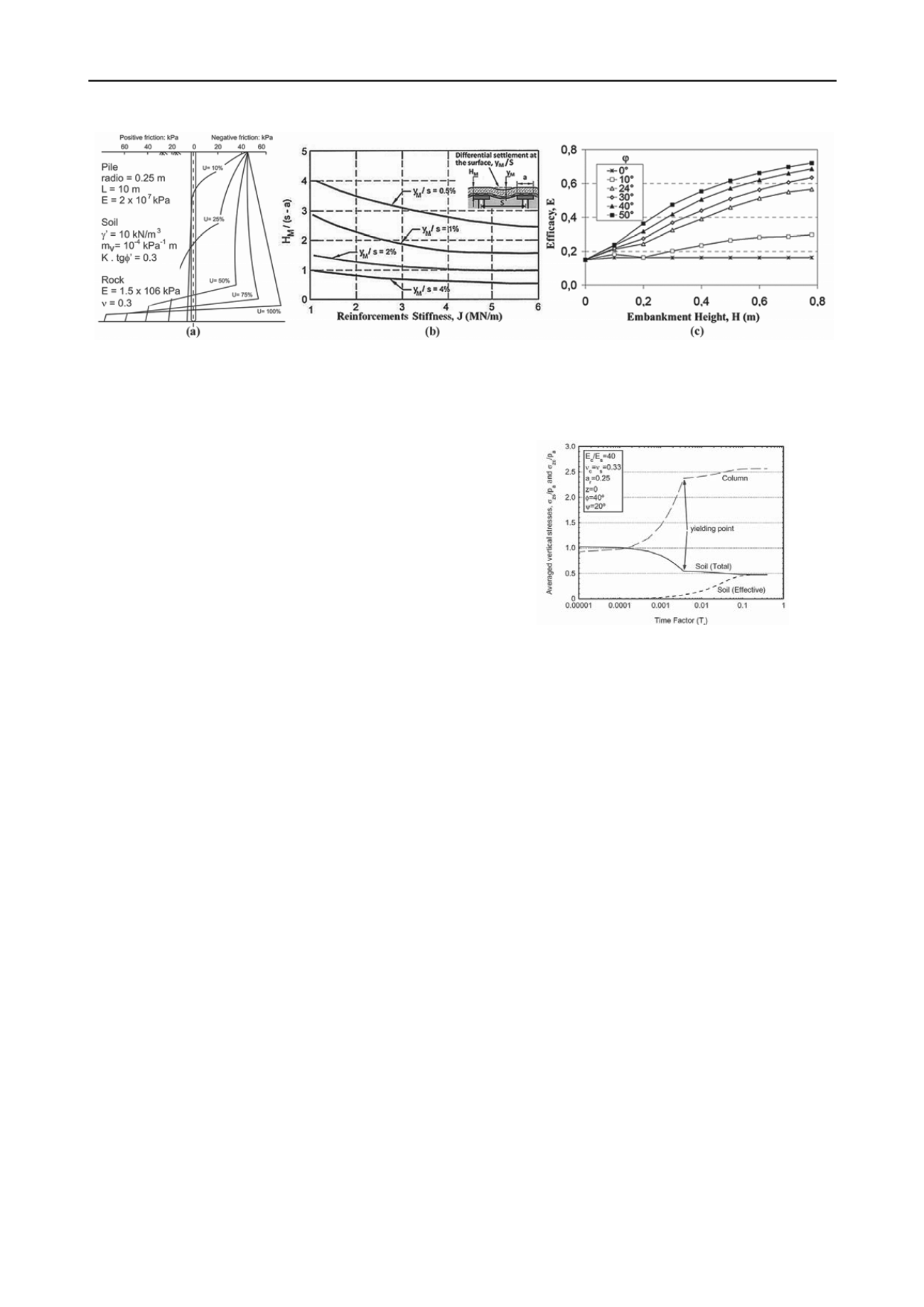
2443
Technical Committee 211 /
Comité technique 211
Figure 4. (a) Estimation of evolution of negative skin friction with degree of consolidation (Alonso et al. 1984); (b) chart for geosynthetic design
based of allowable differential settlement (Lawson 2000); (c) influence of height and friction angle of embankment on Efficacy factor (Jenck 2005).
deformation in the head of rigid inclusions may suppose the
failure state, as settlements may reach levels corresponding
tolarge percent of column diameter. Furthermore, the punching
failure in the head and toe of columns occurs immediately after
the application of embankment load, and associated risk
increases with smaller diameters of rigid inclusion, being quite
sensitive to the variation of the soil parameters also.
On the other side, flexible elements like stone columns tend
to reduce the punching effects at the base of embankment. In
this case the system gives a ductile behavior, whereas, due to
column compressibility and its drainage characteristics, the
ultimate limit state is reached after large deformation and at the
end of consolidation. Therefore, the behavior of such system
takes place in the domain of serviceability limit state (SLS).
Wehr et al. (2012) proposed three categories of increasing
risks, in order to assess the reliability of ground improvement
methods according to their ductility and sensitivity to the
variation of soil and materials parameters, taking as a reference
the standards DIN 1054 and Eurocode 7. Thus, regarding to
columns-type elements, flexible columns with small risks (stone
columns, vibro compaction, sand columns) are in category A;
rigid columns with diameter larger than 30 cm, which presents
an average risk, are in category B; and rigid inclusions with
diameters less than 30 cm and non-ductile behavior, which
represent a high risk, are in category C.
3.2 Consolidation process
The addition of cement agents disables the drainage capacity of
rigid columns, whereby settlements stabilization is obtained
only due to a high load concentration on the columns. However,
during the consolidation of pore pressures produced by the
remaining part of embankment load that act on the soil, an
important negative skin friction is generated in the part of
columns above the neutral plane, very similar to piles, but
without any capacity and structural connections. Consequently,
the risk should be assessed due to possible reduction or loss of
the load concentration on columns (or efficiency factor) along
the lifetime of the CSEs. This situation could occur if certain
loss of arching effect happens, as a consequence of possible
LTPs deteriorations, e.g. due to internal failure of geosynthetic-
reinforcement. In this case, the consolidation would occur in the
long term, according to the permeability of the natural soil.
Moreover, it would involve the evolution of neutral plane
over the time, dominated by the increase of negative friction.
Figure 4a shows an example of this complex mechanism
reported by Alonso et al. (1984).
In the case of stone columns, the rapid settlements
stabilization is expected due to their drainage capability. Castro
and Sagaseta (2009) analyzed the evolution of stress
concentration on the stone columns, showing that in the very
beginning entire load is carried by the soil, and the final load
concentration on the columns is obtained after consolidation
(Figure 5). However, after short period of consolidation,
effective stress of soil tends to increase, and additionally
provides greater confinement to the columns. Such results
suppose an improvement of the whole column-soil system.
Figure 5. Time development of soil and column stresses, (Castro and
Sagaseta 2009)
4
GENERAL ASPECTS OF SAFETY VERIFICATION
There is a range of recommendations that attempt to unify
design of LTPs composed by geosynthetic-reinforcement layers,
basically used in piled embankments (BS8006 2010, EBGEO
2010, Nordic Handbook 2005). However, the design of column-
type elements is redirected to typical pile standards. As it was
mentioned in section 2.2, it has to be emphasized, that these
recommendations deal with systems where almost entire load is
transferred to bearing elements heads, hence negative skin
friction is practically negligible. According to what has been
stated here about the higher level of risk exhibited by the rigid
inclusions with small diameter, the most important safety
aspects of such elements will be commented.
4.1 Large-height embankment
The ASIRI recommendations define two different situations:
Domain 1: if the ULSs are not guaranteed without
improvement, rigid inclusions are used to ensure the global
stability, and bearing capacity of rigid inclusions for both ULSs
and SLSs have to be checked, similarly to the French Eurocode
7 application for piles.
Domain 2: if the ULSs are analyzed for the situation without
improvement, then rigid inclusions are used as settlement
reducers, and only SLSs have to be proceeded.
Taking into account the ASIRI recommendations, it could be
distinguished that when the CSE system comprises
embankments with more than 3 to 5 m height, the design is
usually focused to guarantee the ULSs. Regarding to the
external bearing capacity (GEO) for rigid inclusions, the most
important checks against the permanent loads will be punching
at their heads and tips, as well as the horizontal stresses,
bending moments and shear stresses due to slope
failures.Buckling effects have to be checked when soft soil has
pressuremeter modulus smaller than 3 MPa.


